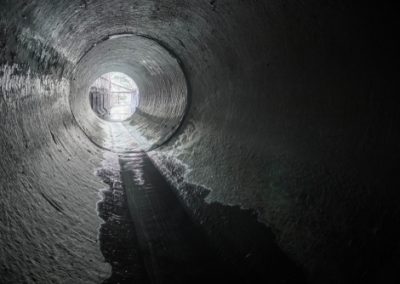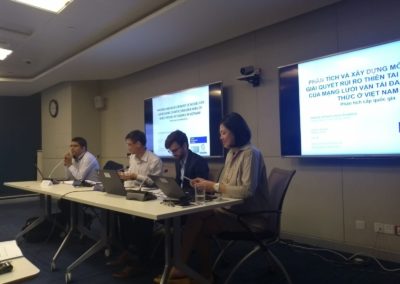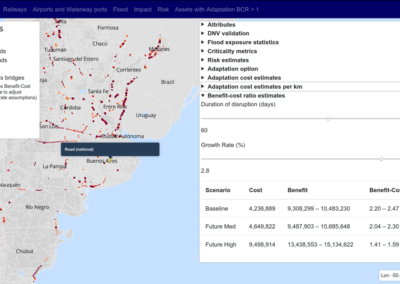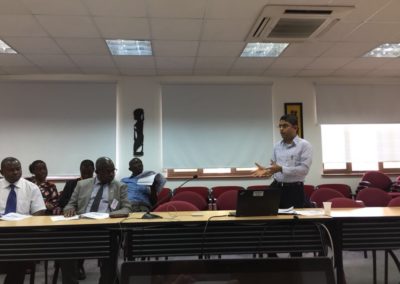THEMES
RISK AND RESILIENCE
RISK AND RESILIENCE
INTRODUCTION
The infrastructure network vulnerability, risk and resilience assessments are methodologies that take a ‘system-of-systems’ approach of modelling interdependent networks reliability and failure cascades. These system-of-systems models incorporate information at finer geographic scales with underlying physical, operational, social, and economic aspects associated with infrastructure systems. The methodological steps involve combining: (1) Spatailly correlated and probabilistic climate hazard events under current and future climate scenarios; (2) Spatial representations of network point and line assets with connectivity to capture failures cascade through the flow of resources (goods, information, etc.); (3) Direct loss measures of the exposures and damages of assets under varying severities of climate hazards; (4) Indirect socio-economic losses resulting from disruptions of infrastructure network services in terms of numbers and monetary values attached to household and business customers; (5) Further regional economic flow losses from production and labour disruptions to outputs of macroeconomic sectors; (6) Risk measures combining hazard probabilities, exposures and direct and indirect vulnerabilities across an exhaustive sampling of possible hazard and network failure and disruption scenarios; (7) Quantifiable options and costs for building resilience (to climate or any shock event) of individual assets and networks; (8) Performing a cost-benefit analysis to access the effectiveness of resilience options and select network assets to priortise for resilience investments.

Illustration of the system-of-systems risk and resilience assessment framework applied to multi-modal transport networks. Source: Oh, J.E., Espinet Alegre, X., Pant, R., Koks, E.E., Russell, T., Schoenmakers, R. and Hall, J.W. (2019). Addressing Climate Change in Transport: Volume 2: Pathway to Resilient Transport. World Bank, Washington DC. doi: http://dx.doi.org/10.1596/32412.
RISK AND RESILIENCE
RESULTS
Analysis to access direct exposures of infrastructure networks to multiple hazards provides the first kind of evidence towards understanding the spatial concentrations of network vulnerabilities. This shows the locations where choices are being made now that will lock in risks for decades to come, threaten the viability of infrastructure investments, and burden countries with escalating economic and human impacts and repair costs.

Global scale analysis of multi-hazard exposures of roads and railways assets, showing (a) exposure for each region in the world; and . (b–f) exposure based on income groups per hazard and per hazard intensity band. Source: Koks, E.E., Rozenberg, J., Zorn, C., Tariverdi, M., Vousdoukas, M., Fraser, S.A., Hall, J.W., Hallegatte, S. (2019). A global multi-hazard risk analysis of road and railway infrastructure assets. Nature communications, 10(1), pp.1-11. Doi: https://doi.org/10.1038/s41467-019-10442-3.

Assessments of failure probabilities of assets exposed to hazards helps indentify the initiating conditions for systemic network failures, which lead to disruptions of network services affecting users. Such evidence provides network planners with information on the assets that have largest impacts on network performance.


Results showing (a) Fragility curves of railways bridge scouring in Great Britain derived from historical bridge failure observations with an assessed flood return period; (b) Rail passenger journeys disrupted for networks edge failures due to bridge scouring; (c) Estimated spatial distribution of daily average number of passenger journeys on the Great Britain rail network. Source: Lamb, R., Garside, P., Pant, R. and Hall, J.W., 2019. A Probabilistic Model of the Economic Risk to Britain’s Railway Network from Bridge Scour During Floods. Risk Analysis, 39(11), pp.2457-2478. Doi: https://doi.org/10.1111/risa.13370
Interdependencies between infrastructure networks cause failure feedbacks into the initiating network, thereby triggering further failure cascades. These cascading failures set a chain of failure mechanisms leading to higher order disruptions across networks. Quantifying the degree to which network failures cascade in a systemic way helps under the influence of interdependencies that exist between different infrastructure networks.


Analysis on interdependent electricity, telecoms, water, railway and road network in Great Britain shows how systemic failures originiating in electicity network create sequences of higher order cascading failures across all networks. Source Pant, R., Russell, T., Zorn, C., Oughton, E. and Hall, J.W. (2020). Resilience study research for NIC – Systems analysis of interdependent network vulnerabilities. Environmental Change Institute, Oxford University, UK. Available at https://www.nic.org.uk/wp-content/uploads/Infrastructure-network-analysis.pdf.
Due to network behaviours infrastructure disruptions create much larger impact footprints than the initiating hazard conditions. This further leads to indirect macroeconomic losses that extend to wider economic sectors in a much severe manner. There is an ‘uplift’ on the magnitudes of economic losses due to infrastructures that would not be seen if only the direct impacts were considered. Such evidence demonstrates the value of a systemic approach to disaster impact modeling. for multiple stakeholders beyond areas immediately impacted by the disaster event.


(a)

(b)
Analysis of electricity failure impacts of labour productivity in South-East England Figures showing: (a) the percentage of loss of labour productivity in areas flooded (left panel) and how these a amplified further when the electricity substations are flooded and disrupted as well (right panel); (b) Macroeconomic losses to different manufacturing and service sectors in the UK economy when considering direct flooding only (left) and with flood plus electricity disruptions (right). Source: Koks, E., Pant, R., Thacker, S. and Hall, J.W. (2019). Understanding business disruption and economic losses due to electricity failures and flooding. International Journal of Disaster Risk Science: 1-18. Doi: http://dx.doi.org/10.1007/s13753-019-00236-y.
Climate adaptation involves incorporating adaptation options to upgrade infrastructure assets to higher climate resilience design standards and assessing the benefit-cost ratios of such adaptation options. This helps build the case for investing in climate resilience which becomes stronger as economic impacts of disruptions increase. Such analyses are proving useful in providing scientific evidence to givernments to develop a national strategy for climate resilient innfrastrucutre plans, as part of contributions to the Nationally Determined Contributions, to meet the Paris Climate Agreement targets.


Results from analysis of road network economic risks due to climate hazard vulnerability in Vietnam showing: (a) the criticality of the national roads highlighted through the mangitudes of economic losses associated with the disruptions of routes exposed to climate hazards; (b) how to prioritise climate resilience investments on national roads based on assessing the benefit-cost ratios of investments associated with climate proofing vulnerable roads. Source: Oh, J.E., Espinet Alegre, X., Pant, R., Koks, E.E., Russell, T., Schoenmakers, R. and Hall, J.W. (2019). Addressing Climate Change in Transport: Volume 2: Pathway to Resilient Transport. World Bank, Washington DC. doi: http://dx.doi.org/10.1596/32412.
For high-level assessment at the national-scale the criticality hotspot maps showcase where concentrations of vulnerable assets of multiple infrastructures can lead to large-scale disruptive impacts at the national-scale. Such evidence is very useful for national policy makers to allocate resources across number of infrastructure networks to prepare for larger-scale low probability and high impact events.


(a)

(b)
Hotspot maps showing high-level concentrations of regions with critical electricity, transport, water, waste and telecommunications assets in (a) England and Wales. Source: Thacker, S., Barr, S., Pant, R., Hall, J.W. and Alderson, D., 2017. Geographic hotspots of critical national infrastructure. Risk Analysis, 37(12), pp.2490-2505. Doi: https://doi.org/10.1111/risa.12840; (b) New Zealand. Source: Zorn, C., Pant, R., Thacker, S. and Shamseldin, A.Y. (2020). Evaluating the magnitude and spatial extent of disruptions across interdependent national infrastructure networks. ASME J. Risk Uncertainty Part B, 6(2). 020904. Doi: http://dx.doi.org/10.1115/1.4046327.
RISK AND RESILIENCE
APPLICATIONS
The risk and resilience models have been used in a wider range of applications over the years. We have worked closely with organisations responsible for infrastructure networks, understanding their needs and developing analytical methods that transform their decision making.
- We are produced the first evidence-based assessment for the National Infrastructure Commission (NIC) characterising vulnerabilities of UK’s interconnected networks under current and future planning scenarios. This work will support NIC’s recommendations towards developing “a framework to assess the resilience of economic infrastructure systems and the costs and benefits of improvements”.
- Our work with the World Bank in Vietnam was the first national-scale multi-modal transport study to analyse network criticalities and risks to evaluate and prioritise climate resilient investments. Equally novel transport risks studies in Tanzania and Argentina contributed methodologies and visualisation tools for improving the knowledge for systemic planning for climate risks.
- For Infrastructure UK our critical hotspot analysis, of mapping interconnected infrastructure networks vulnerability impacts in England and Wales, was the first piece of evidence instrumental in moving the policy “thinking from silo-sectored to a multi-sector and cross-sector one”.
- In another first, our methodology and evidence enabled High Speed 2 map out their interdependencies with legacy networks, to identify and anticipate future vulnerabilities and risks from climate change. This was instrumental in establishing new guidelines that incorporated interdependencies in the design process.
- The Environmental Agency’s (EA) Long-Term Investment Scenarios (LTIS) 2019 policy report included our “ground-breaking work using a unique set of national infrastructure modelling tools”. LTIS 2019 made “significant improvements to the understanding of the potential impacts to infrastructure without resilience”, to improve investment modelling.


RELATED MODELS & DATASETS
snkit
Spatial Networks Data Cleaning Toolkit
Tanzania Transport Risk Analysis
Vietnam Transport Risk Analysis
Argentina Transport Risk Analysis
Risk Analysis Visualisation Tool
RISK AND RESILIENCE
PUBLICATIONS
Addressing Climate Change in Transport: Volume 2: Pathway to Resilient Transport
Climate change is set to have profound effects on Vietnam’s development. With nearly sixty percent of its land area and seventy percent of population at risk of multiple natural hazards, Vietnam ... read more
A global multi-hazard risk analysis of road and railway infrastructure assets
Transport infrastructure is exposed to natural hazards all around the world. Here we present the first global estimates of multi-hazard exposure and risk to road and rail infrastructure. Results ... read more
Understanding business disruption and economic losses due to electricity failures and flooding
Failure of critical national infrastructures can cause disruptions with widespread economic impacts. To analyze these economic impacts, we present an integrated modeling framework that combines: ... read more
Multi-Scale Assessment of the Economic Impacts of Flooding: Evidence from Firm to Macro-Level Analysis in the Chinese Manufacturing Sector
We present an empirical study to systemically estimate flooding impacts, linking across scales from individual firms through to the macro levels in China. To this end, we combine a detailed ... read more
Evaluating the magnitude and spatial extent of disruptions across interdependent national infrastructure networks
Critical infrastructure networks are geographically distributed systems spanning multiple scales. These networks are increasingly interdependent for normal operations, which causes localized ... read more
RISK AND RESILIENCE
CASE STUDIES

Ageing space weather forecasting satellites pose huge risks to UK economy
Space weather events that frequently occur on the surface or the corona of the Sun, also known as solar storms, can cause severe disruption to essential national infrastructure such as power ... read more

Dr Elco Koks wins prestigious Veni grant, funded by the Dutch Research Council (NWO)
ITRC Researcher Dr Elco Koks has been awarded a prestigious Veni grant, funded by the Dutch Research Council (NWO). The Veni is a 250,000 Euro research grant, targeted at outstanding researchers ... read more

Analysis and development of model for addressing climate change/disaster risks in multi-modal transport networks in Vietnam
This analytical work aimed to set out a vision and strategy for climate-smart transport in Vietnam, in order to ensuring its resilience against future risks. read more

Argentina – Transport risk analysis
This study sought to identify locations of vulnerabilities and risks in transport systems due to external shocks from natural hazards driven by climate change in Argentina. read more

Uruguay Road Rehabilitation and Maintenance Program: Training Workshop
A 3-day workshops focused on providing hands-on training on how to work with spatial data and use spatial analysis tools. read more

Cyberattacks on London’s electricity networks costing up to £111m daily
New research shows cyberattacks on London’s electricity networks leads to widespread disruption, costing up to £111m daily. read more

Transport Risk Analysis for The United Republic of Tanzania – Systemic vulnerability assessment of multi-modal transport networks
Researchers expose how climate change will impact Tanzania’s transport systems with knock-on risks for the economy and access to basic services. read more